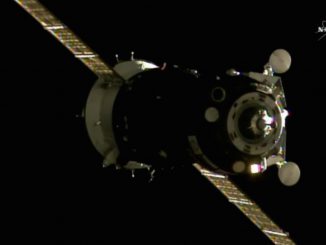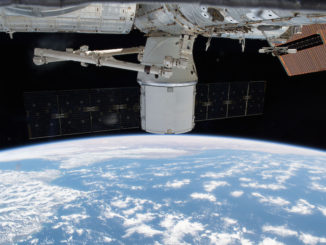
The core module of China’s space station is packaged inside the nose cone of a heavy-lift Long March 5B rocket for liftoff late Wednesday (U.S. time), the first of 11 launches to deliver astronauts, supplies, experiments, and new laboratory modules to build out the orbiting complex before the end of 2022.
The massive Tianhe, or “Heavenly Harmony,” core module will be the keystone of the Chinese space station in low Earth orbit a few hundred miles above the planet, serving as astronaut living quarters, a command and control element, an airlock for spacewalks, and a docking port for attachment of future crew and cargo vehicles.
The fully-assembled outpost will be around 66 metric tons, about one-sixth the mass of the International Space Station, and is closer in size to Russia’s retired Mir station than the ISS. China will add two research modules to the space station in 2022.
The launch is scheduled for a one-hour period beginning at 11 p.m. EDT Wednesday (0300 GMT; 11 a.m. Beijing time Thursday), according to publicly-released airspace warning notices. Several sources suggest the launch is scheduled for approximately 11:18 p.m. EDT (0318 GMT), although the Chinese government has not disclosed an exact liftoff time.
China has not announced any plans to broadcast the launch live on state-run television.
The liftoff of the Tianhe core module begins the most ambitious project in the history of China’s human spaceflight program, which seeks to create its own space station after being shut out of the International Space Station, led by U.S. and Russian space agencies.
The core element of the space station will blast off on China’s most powerful launcher, the Long March 5B, with 10 engines burning liquid hydrogen and kerosene fuel. The 176-foot-tall (53.7-meter) Long March 5B rocket rolled out to its launch pad Friday at the Wenchang spaceport on Hainan Island, China’s southernmost province.
Gantry arms folded into position around the rocket to allow ground teams to finish preparations for liftoff. Liquid hydrogen, kerosene, and liquid oxygen propellants will begin loading into the Long March 5B a few hours before launch.
The fully-fueled Long March 5B rocket will weigh more than 1.8 million pounds (849 metric tons) at launch. The rocket’s liquid-fueled engines will power the launcher off the pad with about 2.4 million pounds of thrust, guiding the rocket toward the southeast from Wenchang over the South China Sea.
The Long March 5B will shed its four expendable strap-on boosters about three minutes after liftoff, and the rocket’s payload fairing will jettison about 3 minutes, 40 seconds, into the mission. The rocket’s cryogenic center stage will place the Tianhe spacecraft into orbit and deploy the space station module about eight minutes after launch.
The Long March 5B is a variant of China’s heavy-lift Long March 5 rocket specially designed to haul heavy elements of China’s space station into orbit. The Long March 5B flies without the Long March 5’s second stage, making room for a large spacecraft to fit inside the rocket’s payload shroud.
China demonstrated the Long March 5B rocket on a successful test flight in May 2020, proving the rocket’s readiness to launch components of the Chinese space station. Six Long March 5 rockets have launched in various configurations, and the last four Long March 5 missions have been successful, with five successes overall.
The Tianhe module measures more than 54.4 feet (16.6 meters) long, has a maximum diameter of around 13.8 feet (4.2 meters), and has a launch weight of roughly 49,600 pounds (22.5 metric tons), according to China’s state-run Xinhua news agency. It’s the largest and heaviest spacecraft ever built in China.
The core module resembles the first section of Russia’s Mir space station, but the Tianhe spacecraft is longer and heavier.

The 11 missions to kick off assembly of China’s space station include the the launch of three pressurized modules on Long March 5B rockets and resupply flights using Tianzhou cargo freighters launched on Long March 7 rockets from Wenchang. The flights will also include Shenzhou crew capsules launched on Long March 2F rockets from Jiuquan, an inland spaceport in the Gobi Desert in China’s Inner Mongolia region.
China launched two Tiangong prototype space labs in 2011 and 2016 to test out technologies for the permanently-occupied space station.
The Tiangong 1 space lab hosted two Shenzhou crew in 2012 and 2013, and China’s most recent human spaceflight mission — Shenzhou 11 — docked with the Tiangong 2 module in 2016.
In total, China has launched six astronaut missions on Shenzhou capsules since 2003.
China also launched a test flight of the Tianzhou supply ship, similar in function to Russia’s Progress or SpaceX’s Cargo Dragon capsule supporting the International Space Station. The first Tianzhou freighter took off on a Long March 7 rocket in 2017 and docked with the Tiangong 2 space lab, proving out automated docking and in-orbit refueling technology.
After the Tiangong pathfinders verified key technologies for the Chinese space station, officials are moving ahead with integrating the complex in low Earth orbit between 210 miles (340 kilometers) and 280 miles (450 kilometers) above Earth.
Once the Tianhe module is in orbit, Chinese space officials will complete preparations for launch of a Long March 7 rocket in May carrying the Tianzhou 2 resupply ship. The cargo freighter will automatically dock with the Tianhe module a few days after launch, setting the stage for liftoff of a Long March 2F from the Jiuquan space base as soon as June with the first astronaut crew to visit the nascent space station.
Chinese officials have said they have selected crew members for the Shenzhou 12 mission, and astronaut training is underway. The astronauts will carry out multiple spacewalks on their mission to link up with the Tianhe module in orbit.
The Tianhe core module has handrails to assist astronauts moving around outside the space station on spacewalks.

Chinese officials say the space station is designed to operate for more than 10 years. Once assembly is complete, the station will be able to permanently host three astronauts, with short-term stays of six astronauts possible during crew changeovers.
The core module has an internal living volume of about 1,765 cubic feet (50 cubic meters), according to Xinhua. With all three modules, the living space will grow to 3,884 cubic feet (110 cubic meters). For comparison, NASA says the International Space Station has a habitable volume of 13,696 cubic feet (388 cubic meters).
One of the two research modules scheduled for launch next year, named Wentian, will have a larger airlock than the Tianhe core module to support spacewalks, plus a robotic arm to move payloads and science experiments outside the space station.
The other research module, named Mengtian, is similar to Wentian but has a special airlock to transfer cargo and instruments between the interior and exterior of the space station, Xinhua said.
Email the author.
Follow Stephen Clark on Twitter: @StephenClark1.



